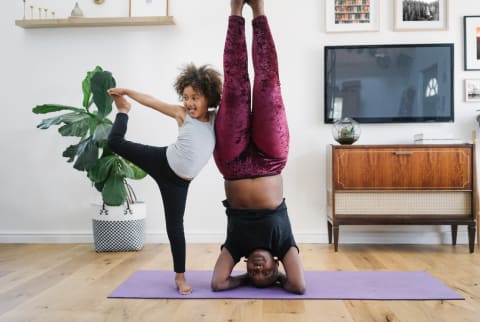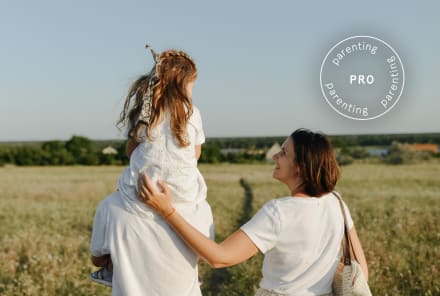Advertisement
An Optimism Expert On How To Raise Kids With A 'Glass Half Full' Perspective


In today’s world of fast technology, overabundance of choice, and quick fixes, we are seeing more of a decrease in human interactions and empathy—and with the pervasive rise of social media, we are seeing an increase in narcissism along with lower self-esteem, especially in our kids. It’s no wonder that one of the most common things I am asked in my practice is how parents can not only deal with striking a balance for themselves but how they can raise well-adjusted, more optimistic, happier kids.
Before I make any suggestions to parents, I always like to redefine the word "optimism" beyond the term most people just attribute to "always seeing the positive." In my world, an "optimist" has a more functional definition: someone who holds two important beliefs—first, that their problems (which they are aware exist) are temporary, and second, that their personal actions can indeed diminish or alleviate these problems. More often than not, optimists hold a positive attitude and see "setbacks" as temporary and even as opportunities, while pessimists see them as problems that are permanent and, most of the time, of their own doing—which we know can be a hallmark of depression.
The good news? Much of the research today points to the elasticity of our brains and the ability of the human mind to make meaningful changes at a neural level. People who have been prone to pessimism, or are just more pessimistic by practice, can indeed rewire themselves to see more opportunity and positive future outcomes. It is important to note that yes, genetics play a role, but genes account1 for no more than 33 percent of whether one person will be more optimistic than another. That leaves us with almost a whole 70 percent to work with! I always like to reiterate that optimism is like a muscle, and the more we can work this muscle out, the more we can raise our optimism factor and positive attitudes. This could not be truer for our kids, and it is beneficial to start working out this muscle early on.
Just like any muscle, there are some specific exercises you can do in the comfort of your own home to help raise your kids to be more optimistic. Keep in mind that these exercises are for adults, too, and that practicing what you preach and modeling these exercises yourself will, in turn, make your kids much more likely to practice them:
1. Meditate and practice mindfulness
Teach your child simple practices of meditation and mindfulness: You in no way have to be a meditation expert in order to teach your child to simply breathe and focus on his/her breath for five minutes a day—just that alone will have great benefits on decreasing stress and anxiety levels and help your child learn a sense of self-control and self-regulation, all important factors for increasing optimism!
2. Move
Simply encouraging your child to exercise or stay active every day will help your child release endorphins, which is a natural way to increase happiness! Better yet, if you help them tie in goal-setting with physical activity, whether individually or by joining team sports, you will be helping them create a sense of self-mastery and successful goal setting and achieving! This will then naturally spill into other aspects of their lives.
3. Practice not-so-random acts of kindness
Inspiring your child to perform acts of kindness with a specific intention is very important! People who are purposefully and mindfully kind to others experience greater mental health by way of increased positive mood and self-esteem. Being able to actively decide to do something kind, then take the actions to do it, and lastly being able to witness the positive impact firsthand helps your child’s brain to build empathy and an immediate sense of control over his/her environment for the greater good.
4. Recognize gratitude
Help your child make space to routinely name their sources of gratitude out loud to you and the rest of the family, maybe at dinner or before bedtime. Better yet, make it an interactive routine, where you all name two or three things you are thankful for at the dinner table. When your child identifies what he/she is thankful for, the brain automatically is able to boost positive moods and give accessibility to more things that make your child happy.
5. Hunt happiness
If you can encourage your child to keep a positivity journal, spending 10 minutes a day three times a week writing down a positive experience they had that day, their brains in turn will be more open to easily receive and notice other positive experiences. This practice will grow and grow, and soon your child will be a natural happiness seeker! For younger children, I love the idea of going on "happiness scavenger hunts"—this promotes the idea of hunting for happiness and also increases their mindfulness practice! It consists of walking around the world with them, asking them to point out whatever objects, people, things make them smile or laugh!
There are plenty of things in our world that without intention frighten or upset us, so being able to practice this is a surefire way to really work on that optimism muscle.
Want more tips for working on your positivity muscle? Here are some ideas.
Watch Next
Enjoy some of our favorite clips from classes
Enjoy some of our favorite clips from classes
What Is Meditation?
Mindfulness/Spirituality | Light Watkins
Box Breathing
Mindfulness/Spirituality | Gwen Dittmar
What Breathwork Can Address
Mindfulness/Spirituality | Gwen Dittmar
The 8 Limbs of Yoga - What is Asana?
Yoga | Caley Alyssa
Two Standing Postures to Open Up Tight Hips
Yoga | Caley Alyssa
How Plants Can Optimize Athletic Performance
Nutrition | Rich Roll
What to Eat Before a Workout
Nutrition | Rich Roll
How Ayurveda Helps Us Navigate Modern Life
Nutrition | Sahara Rose
Messages About Love & Relationships
Love & Relationships | Esther Perel
Love Languages
Love & Relationships | Esther Perel











